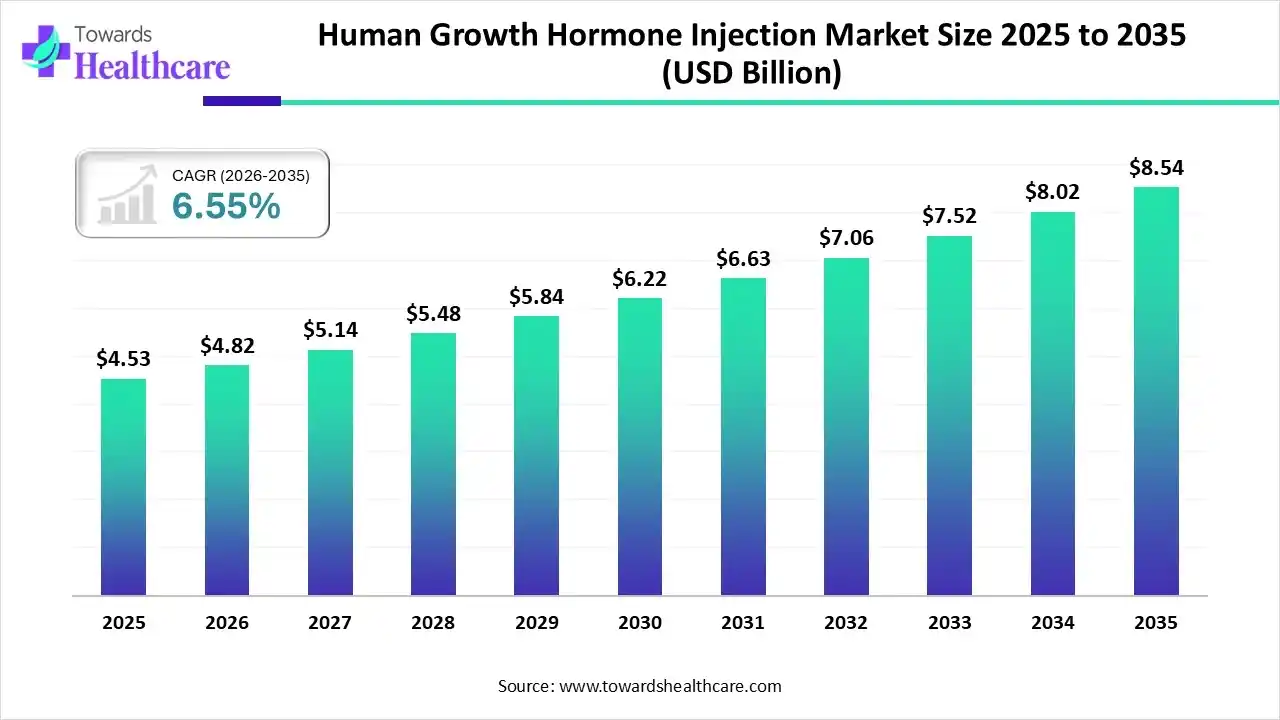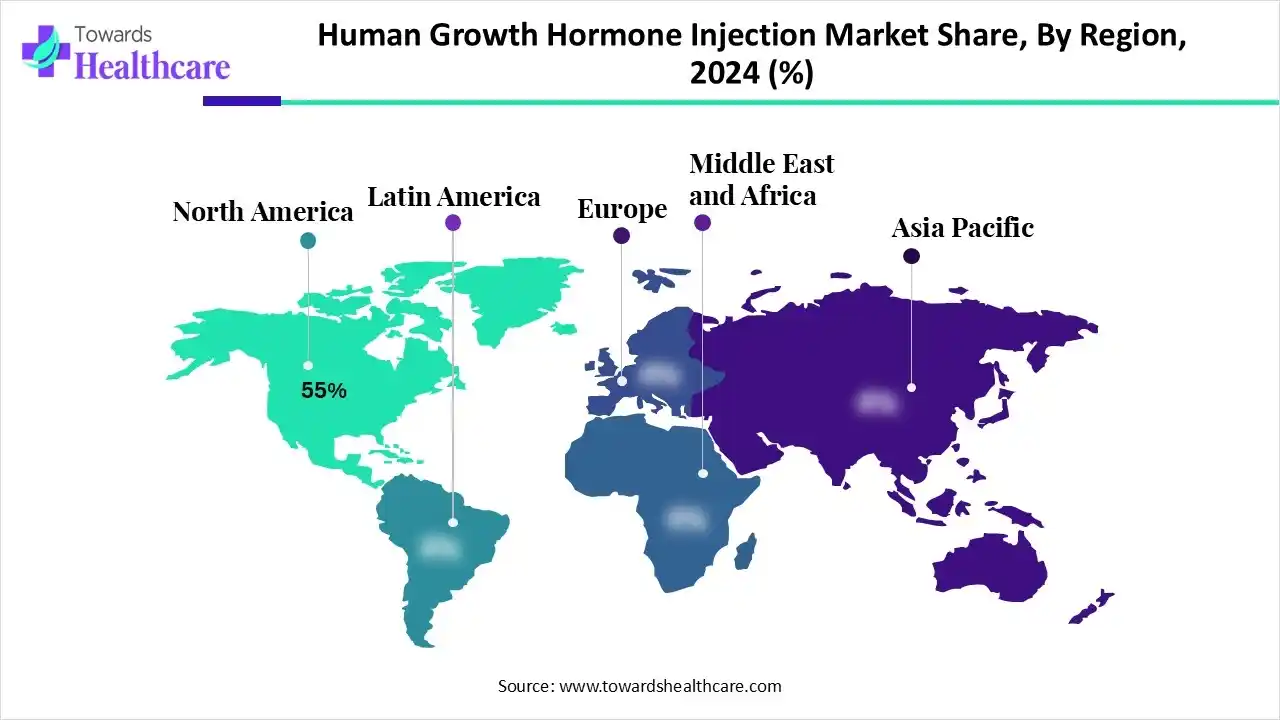November 2025

The human growth hormone injection market size touched US$ 4.53 billion in 2025, with expectations of climbing to US$ 4.82 billion in 2026 and hitting US$ 8.54 billion by 2035, driven by a CAGR of 6.55% over the forecast period.

The human growth hormone injection market is growing because increasing incidence of growth hormone deficiency and associated disorders. North America is dominant in the market as increasing awareness in healthcare providers and patients and developed in delivery technology, while the Asia Pacific is fastest growing the fastest-growing market due to adoption of auto-injector device technology and manufacturing of long-acting formulations.
| Key Elements | Scope |
| Market Size in 2026 | USD 4.82 Billion |
| Projected Market Size in 2035 | USD 8.54 Billion |
| CAGR (2025 - 2035) | 6.55% |
| Leading Region | North America by 55% |
| Market Segmentation | By Drug Type, By Formulation/Technology, By Application/Therapeutic Area, By Route of Administration, By Distribution Channel, By Type of Manufacturer, By Region |
| Top Key Players | Pfizer Inc., Novo Nordisk A/S, F. Hoffmann-La Roche AG, Eli Lilly and Company, Sanofi S.A., Teva Pharmaceutical Industries Ltd., Sandoz (Novartis Group), Genentech, Inc., Ascendis Pharma A/S, Chugai Pharmaceutical Co., Ltd., LG Chem Ltd., BioMarin Pharmaceutical Inc., Intas Pharmaceuticals Ltd., Abbott Laboratories, Amgen Inc., OPKO Health, Inc., Ipsen Pharma, Samsung Bioepis, Bharat Serums and Vaccines Ltd., Zydus Cadila |
The human growth hormone (HGH) injection market refers to the global market for therapeutic injections of recombinant or synthetic growth hormones used to treat growth deficiencies and other related endocrine or metabolic disorders. HGH injections are primarily prescribed for pediatric growth hormone deficiency, adult growth hormone deficiency, Turner syndrome, Prader-Willi syndrome, chronic kidney disease-related short stature, and conditions involving muscle wasting or metabolic dysfunction.
The human growth hormone injection market encompasses branded and generic peptide drugs, biosimilar HGH products, recombinant DNA-based formulations, and associated delivery devices such as pre-filled pens and syringes. Increasing awareness of growth disorders, rising incidence of endocrine deficiencies, technological advancements in drug delivery systems, and growing adoption of biosimilars are driving market growth across regions.
The Easypod is an automated electronic injection device for the delivery of growth hormone. It saves consumer time and lowers administrative mistakes, the dose is shown by a doctor or nurse. Furthermore, to allow patient adherence to be monitored, the date, time, and dose (mg) of every injection are recorded. Medicine use is optimized by administering the dose over two cartridges, with an automatic compensation ability to evade underdosing. Patients customize the speed, depth, and duration of the injection. This technology modernizes the growth hormone (GH) treatment procedure for patients. It offers consistent real-time injection information to support monitoring patients’ development and make informed treatment decisions.
By drug type, the branded HGH injections segment led the human growth hormone injection market with a 65% share, as branded HGH injections are prescription drug molecules involving synthetic growth hormone. They are manufactured by pharmaceutical companies under different brand names and are designed to replace the natural hormone in patients who have a hormone deficiency. These injections are applied to treat health conditions that cause growth failure or muscle wasting.
On the other hand, the generic HGH injections segment is projected to experience the fastest CAGR from 2025 to 2034, as generic HGH is a significant medication and is only legally and safely attained with a doctor's prescription. They promote tissue growth, support protein, strengthen muscles, grow fat, and enhance exercise tolerance. They help in the entire growth of the human body. Generic drugs are biologically equal to brand-name drugs in dosage form, strength, safety, route of administration, performance characteristics, quality, and intended use.
By formulation, the recombinant DNA (rDNA) HGH segment is dominant in the human growth hormone injection market in 2024, with approximately 85% share, as recombinant DNA technology has made a groundbreaking impact in the area of healthcare by allowing mass production of pure, safe, and more efficient versions of different biochemicals applied as therapeutics. Recombinant hGH is available with great development in managing children lacking the ability to produce hGH in a needed quantity.
The natural/extracted HGH segment is expected to experience the fastest growth from 2025 to 2034, as this hormone supports accelerating healing after an injury and repairing muscle tissue after exercise. This supports building muscle mass, enhancing metabolism, and burning fat. It influences height increment and supports building bones and muscles. Natural levels of growth hormone vary during the day, apparently influenced by physical activity and exercise.
By application, the pediatric growth disorders segment led the human growth hormone injection market in 2024, with a 40% share, as human growth hormone (HGH) is a natural hormone pituitary gland releases that encourages growth in pediatric patients, supporting to maintenance of normal body structure. hGH helps healthy metabolism, steadying blood sugar in younger kids, and promotes the progress of the brain, teeth, liver, and hair. Hormone therapy supports children to catch up in height, particularly during puberty when growth typically ramps up.
The metabolic disorders segment is projected to experience the fastest CAGR from 2025 to 2034, as GH impacts metabolism significantly by properly regulating the production of insulin-like growth factor-1 and its subsequent outcome on peripheral cells. Mostly, cells move into an anabolic protein state with improved amino acid uptake, protein synthesis, and lower catabolism of proteins. It is known for its effect on musculoskeletal anabolism and bone growth.
By route of administration, the subcutaneous injection segment led the human growth hormone injection market in 2024, with a 90% share, as this type of drug delivery offers a patient-friendly, less invasive technique for the administration of medication, enhancing patient adherence and comfort. Subcutaneous administration enables therapeutics to be self-administered by patients or healthcare professionals using a variety of different drug delivery systems, including modern subcutaneous drug delivery tools.
The intramuscular injection segment is projected to experience the fastest CAGR from 2025 to 2034, as it provides quick and uniform absorption of the drug, particularly the aqueous solutions. IM injection avoids the first-pass metabolism of the drug. It also eliminates the gastric factors leading to drug absorption. It has high efficacy and potency comparable to that of the intravenous drug delivery technique. Highly effective for emergency situations like acute psychosis and status epilepticus
By distribution channel, the hospital pharmacies segment led the human growth hormone injection market in 2024 with a 45% share, as this type of pharmacies are allowed to handling, purchasing, pricing, storing, and distribute medications. Furthermore, it offers proper drug information to all healthcare professionals and the patient. Hospital pharmacists provide specifications for buying drugs, biological medications, and chemicals.
The online pharmacies segment is projected to experience the fastest CAGR from 2025 to 2034, as these types of pharmacies are a link between patients and essential medications, specifically for those living in underserved or remote areas. Online platforms ensure that patients get the medication solutions they require without having to travel further distances. Many online pharmacies source medicines from reliable suppliers, ensuring authenticity and quality.
By type of manufacturer, the in-house manufacturing segment led the human growth hormone injection market in 2024 with a 70% share, as this type of production allows pharmaceutical organizations to adapt more quickly to fluctuations in market demand or regulatory needs, thus enhancing their entire competitiveness. In-house manufacturing in the pharmaceutical industry allows companies to exert full control over the production procedure, with full compliance with quality standards and government requirements of relevant government bodies.
The outsourced manufacturing segment is projected to experience the fastest CAGR from 2025 to 2034, as healthcare outsourcing manufacturers are highly skilled, specialized in their field of production, and have proper knowledge of guidelines and processes, which make them capable manufacturing units. This permits bringing out the high-quality health care products. They are equipped with attentive facilities, tools, infrastructure, and skillful staff, which support companies in saving costs.

North America is dominant in the human growth hormone injection market in 2024 with a revenue of 55%, due to the region having a well-established and advanced medical care infrastructure, including sophisticated diagnostic techniques, which allow for early and precise diagnosis of growth hormone deficiencies (GHD) and associate disorders. High healthcare investment enables extensive healthcare research and the increasing adoption of modern therapies.
In the U.S., growing prevalence of growth hormone deficiencies in children and adults, as well as advancements in treatment delivery systems. Technological innovations, such as pen devices and auto-injectors, are making injections easier and more suitable for patients, therefore enhancing compliance.
Asia Pacific is the fastest-growing region in the human growth hormone injection market in the forecast period, as growing medical care spending, rising awareness of growth disorders, and enhanced medical care infrastructure. Major countries are increasing funding and research for rare disease treatments, which include covering therapies such as HGH. Growing access to better hospitals and particular diagnostic equipment is leading to earlier detection of growth hormone deficiencies, which drives the growth of the market.
For Instance,
In China growing awareness and increased diagnosis of growth hormone deficiency and associated health conditions, such as idiopathic short stature. A predictable 7 million children in China need growth hormone therapy for short stature, which increases the demand for growth hormone. Increasing clinical studies, for instance study conducted from January 2017 to April 2024 it observed that children with SS tended to start rhGH treatment at a relatively older age and to exhibit a high rate of treatment discontinuation.
Europe is a notably growing region in the market due to major European countries having modern diagnostic strength and high health awareness, leading to the earlier detection of growth hormone deficiencies in children and adults. Increasing government support, for instance, in April 2025, the European Medicines Agency (EMA) authorized the once-weekly human growth hormone injection, Ngenla (somatrogon), for adolescents and children.
Germany has a mature network of endocrinologists and pediatricians, which helps ensure early detection and management of HGH deficiency. Recent progress in delivery systems, like long-acting formulations and smart injection tools, is increasing patient adherence and management convenience.
The research and development (R&D) processes for human growth hormone injection mainly include recombinant DNA technology, widespread testing, and multiple clinical trial phases. HGH is produced synthetically using genetically engineered bacteria to confirm a plentiful and effective supply.
Key Players: Ipsen and GeneScience Pharmaceuticals Co., Ltd.
Clinical trials of human growth hormone injection involve progression that is highly regulated, needs extensive documentation and oversight, and characteristically progresses through Phase 1, Phase 2, and Phase 3 studies before regulatory approval.
Key Players: Pfizer Inc. and Merck & Co., Inc.
Patients receiving human growth hormone (HGH) injections are typically provided with inclusive services to help them throughout their treatment. These services mainly focus on informing patients and caregivers, confirming safe and correct administration of the drug.
Key Players: Eli Lilly and Ascendis Pharma
By Drug Type
By Formulation/Technology
By Application/Therapeutic Area
By Route of Administration
By Distribution Channel
By Type of Manufacturer
By Region
November 2025
November 2025
October 2025
October 2025